Phu Yen’s top six natural beauties
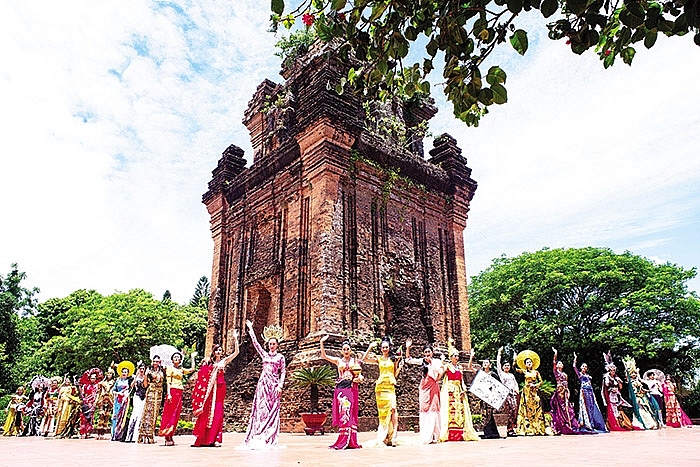 |
| The contestants of the Miss ASEAN Friendship 2017 beauty pageant at the picturesque Nhan Tower, built by the Cham people |
Phu Yen is not as crowded as the beaches of Nha Trang and Danang. There are few luxury accommodations and modern conveniences, but it is the perfect destination to help cut yourself off from daily life and immerse yourself in nature.
The location is an important focus of the province’s tourism campaign and enjoys a strategy to maintaining its raw natural beauty. Thanks to these favourable conditions, Phu Yen has gained somewhat unexpected results in tourism development. Current highlights include O Loan lagoon, Da Bia Mountain, Xuan Dai Bay, Bai Mon Beach, Mui Dien Cape, and Mang Lang Church.
The province hosted the Miss ASEAN Friendship 2017 beauty contest that attracted a large number of participants to show-off their talent in photography and filmmaking as well as highlight trade and tourism activities, while introducing the magnificent scenery.
The beaches in this area are mostly flat, with white sand, clear blue water, and gentle waves. Tourists can enjoy ample tuna, lobster, crab, and squid, both at restaurants and dedicated fish markets. Every morning, you can see people walking back and forth between the boats and land, carrying huge tuna in nets. You can also taste tuna sashimi with soy sauce and wasabi right there, or eat a bowl of hot soup made of tuna eyes.
Brilliant sunrise on Dai Lanh Cape
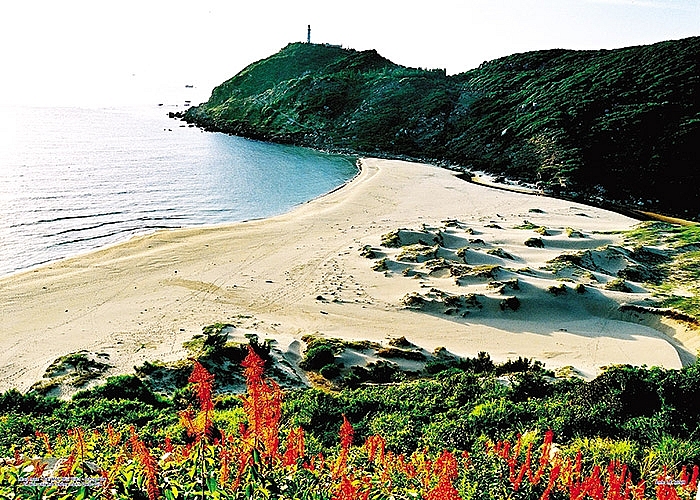 |
Dai Lanh Cape, also called Dien Cape, is in the southeast of Phu Yen, about 30 kilometres from Tuy Hoacity. The cape is the end of the Dai Lanh mountain range, which is a branch of Truong Son.
There are two ways to get to the cape. One is to head north from Nha Trang, follow the Ca Pass to Vung Ro Bay, and the other is to go from Tuy Hoa, following the 40-km coastal road. The road has just been completed and is easier to follow and is shorter than the first road, while also being less crowded. One can listen to the sound of waves crashing into the shore and the wind blowing.
Mon Beach is 400-metres long, running from Nay Cape to Dien Cape, with white sand, blue water, slight slopes, and gentle waves. From Mon Beach one can also walk 15-20 minutes to get to the lighthouse, which was built in 1890 by the French in order to guide ships coming in and leaving Vung Ro Bay. The lighthouse was destroyed during the war. In 1995 it was rebuilt and went back into operation. It is now one of the eight lighthouses in Vietnam that are more than 100 years old and one of the 79 lighthouses currently operating.
Pristine Da Dia rock palate reef
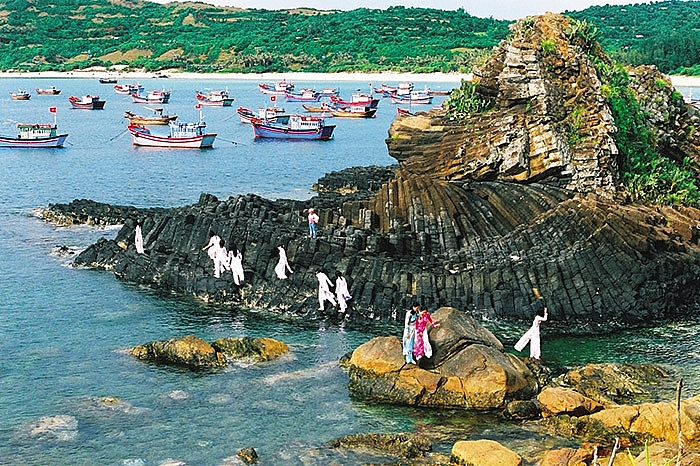 |
Da Dia reef is located in Tuy An district, 40km from Tuy Hoa city. It has an area of two square kilometres, a width of about 50m and a length of 200m. It is a unique natural sight composed of thousands of basalt columns with rough flat surfaces of different shapes, such as pentagons, hexagons, and polygons. From afar, the reef looks much like a beehive.
The area changes as it gets more popular. The road from Tuy Hoa city to Da Dia reef is now covered in asphalt, instead of being an uneven dirt road like it used to be. People living around the area set up shops near the ticket counter and the parking area to sell snails, mangoes, and pineapples.
Awe-inspiring Vung Ro Bay
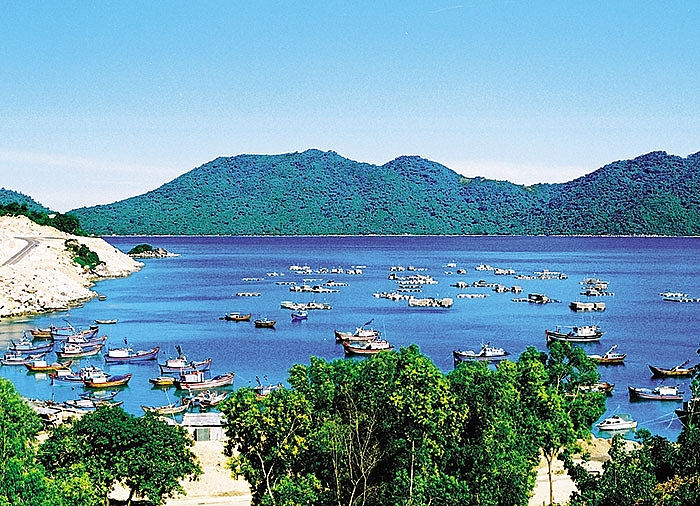 |
Covering an area of 16.4 square kilometres, Vung Ro Bay is host to many stunning beaches, including Lach, Mu U, Nga, Chua, Chan Trau, Ho, Hang, Nho, Chinh, Bang, Lau, and Nhan beaches. Vung Ro Bay’s fame is tied to the name of Ho Dat Thanh, the Hero of the People’s Armed Forces, who helped the Vietnamese navy secretly transport and successfully deliver 200 tonnes of weapons and six officers to the southern battlefield during the Vietnam war.
Alongside Da Bia Mountain, Vung Ro Bay and Ca Pass create an amazing cauldron of attractions for the province. From the top of Da Bia giant rock surrounded by white clouds from dusk till dawn, one can see famous locations such as Vung Ro Bay, Ca Pass, Bang Beach, Mon Beach-Dien Cape, Hiem Mountain, and Van Phong Bay of the central province of Khanh Hoa.
Precious sound of stone instruments
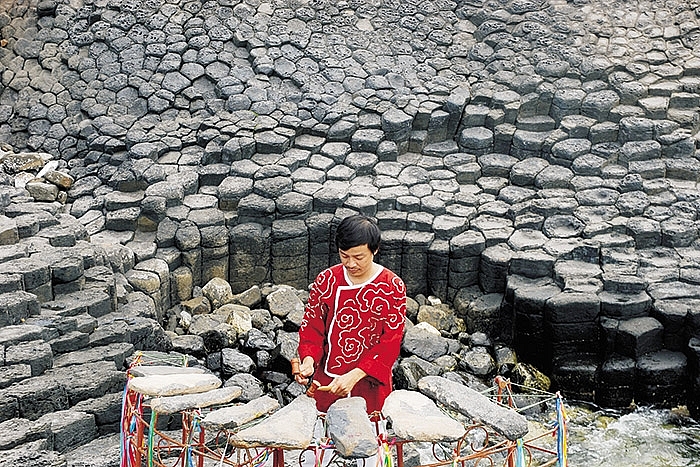 |
Phu Yen’s culture of rocks features two of the most unique stone objects created by human hands: the set of stone bugles with the widest sound spectrum in Vietnam and the most unique musical instruments in the world. Some stone bugles were discovered in the early 1990s in An Nghiep commune by Huynh Ngoc Hong, while another set was unearthed by Do Phan in An Tho commune, then preserved in Thien Son Pagoda, An Hiep commune.
The two sets of stone bugles in Phu Yen, which date back about 2,500 years, are recognised national heirlooms, and have been proposed to the UNSECO to be recognised as a world cultural heritage. Currently, the bugles are preserved at Phu Yen Museum.
Charming Cham at Nhan Mountain
Nhan Mountain is 64m higher than the sea level, with a diameter of one kilometre. The ecology in the mountain is well preserved, with beautiful views, cool air, and a clean winding road.
On the mountain top stands the ancient Cham tower known as Nhan Tower, built by the Cham people in the late eleventh century. From the top of the mountain, one can see the whole of Tuy Hoa city, its blue seas and large fields of rice.
Nhan Mountain and the Da Rang River area is considered the symbol of Phu Yen. In 1988, Nhan Mountain was recognised as a national architectural monument by the Ministry of Culture, Sports and Tourism.
Imposing Xuan Dai Bay
Xuan Dai Bay is 13,000 hectares in area, with the estuary stretching about 4.4km width, with depths of 7-18m.
The bay itself has witnessed important historic events. The Tay Son army and the Nguyen Dynasty had a battle here. The bay was also a vibrant site of commerce. In 1832, a diplomatic delegation from the United States brought a message from the American president to diplomat Nguyen Tri Phuong, who was assigned by King Minh Mang to receive it. The message established a trade relationship between Vietnam and the US.
What the stars mean:
★ Poor ★ ★ Promising ★★★ Good ★★★★ Very good ★★★★★ Exceptional
 Tag:
Tag:
Related Contents
Latest News
More News
- The destinations powering Vietnam’s festive season travel demand (December 04, 2025 | 18:33)
- Vietnam named among the world’s most exciting winter destinations (December 04, 2025 | 15:10)
- Phu Tho emerges as northern Vietnam’s new tourism hub (December 01, 2025 | 17:00)
- Vietjet completes Airbus A320/A321 updates ahead of deadline (December 01, 2025 | 09:49)
- Vietjet resumes Con Dao flights from early December (November 28, 2025 | 15:24)
- Free tickets, Lunar New Year promotions on offer at Vietjet Mega Livestream (November 26, 2025 | 15:32)
- Scandinavian Airlines and Vietnam Airlines broaden agreement with new routes (November 25, 2025 | 17:04)
- Halong Cruise Port welcomes over 3,100 international visitors (November 12, 2025 | 18:06)
- Vietnam.travel climbs to second place in Southeast Asia website rankings (November 12, 2025 | 18:01)
- Cat Ba named among Southeast Asia’s top island adventures (November 11, 2025 | 18:09)






















 Mobile Version
Mobile Version